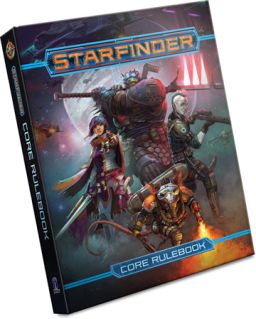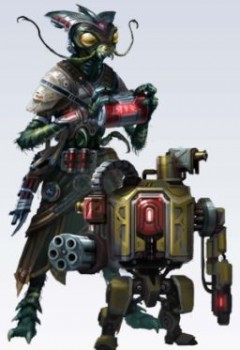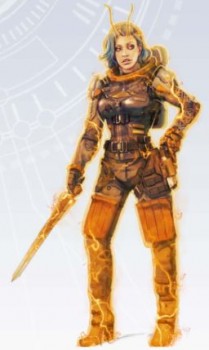Modular: Starfinder Under the Hood – Character Creation
 When playing Dungeons & Dragons or other fantasy RPGs, have you ever wanted to play a space wizard? A gnome with a jet pack? Or a fighter with a flaming laser sword and a force field?
When playing Dungeons & Dragons or other fantasy RPGs, have you ever wanted to play a space wizard? A gnome with a jet pack? Or a fighter with a flaming laser sword and a force field?
These options are all available to you in the new Starfinder RPG (Paizo, Amazon). Paizo has built the new science fantasy game to explore the distant future of their Pathfinder universe. Though I’ve been excited about it for over a year, since it was first announced, I’ve only just gotten the opportunity to play a full game of it.
So now that the game is more than an abstraction … now that I’ve actually rolled the dice and taken some damage … does it still hold up like I was hoping? Honestly: Even better.
But rather than just singing the praises of the game (which I’ve and others have already done here and here and elsewhere), I’m going to dive a bit deeper into how the game is similar – and different – from the Pathfinder game that we know and love.
The character creation is mostly, but not entirely, familiar to those who have played Dungeons & Dragons or Pathfinder before. For ability scores, for example, there’s the random dice-rolling method, a point-buy system (which I used, since I was creating characters for a Starfinder Society organized play game), and an array method where you get set scores that you can then assign to the abilities you want.
Character Races
Then you pick a race. This is where things get a little different, because the core races are not your dad’s RPG races (mostly):
- Android – Artificial beings who have only recently gained equal rights as citizens.
- Human – You know ’em, you love ’em.
- Kasatha – Four-armed desert nomads
- Lashuntas – A dimorphic race (two stat modifier possibilities) with limited telepathy and antennas (looking sort of like Mantis from Guardians of the Galaxy 2).
- Shirrens – A bug race, formerly enslaved to a really mean bug race.
- Vesk – A muscular, militant, reptilian race.
- Ysoki – A race of small ratfolk.
 These aren’t the only races available. Chapter 13: Pathfinder Legacy of the Core Rulebook offers a “Legacy Races” section that outlines the statistics of core Pathfinder races like Dwarves and Elves for use in Starfinder, even though these races are less common among the stars than they were on Golarion. And the Starfinder: First Contact booklet and upcoming Alien Archive (Paizo, Amazon) feature aliens, including some that can be playable races. However, these are not initially available for Starfinder Society organized play (although, as I understand it, you can unlock them as reward boons for GMing a certain number of sanctioned Starfinder Society games).
These aren’t the only races available. Chapter 13: Pathfinder Legacy of the Core Rulebook offers a “Legacy Races” section that outlines the statistics of core Pathfinder races like Dwarves and Elves for use in Starfinder, even though these races are less common among the stars than they were on Golarion. And the Starfinder: First Contact booklet and upcoming Alien Archive (Paizo, Amazon) feature aliens, including some that can be playable races. However, these are not initially available for Starfinder Society organized play (although, as I understand it, you can unlock them as reward boons for GMing a certain number of sanctioned Starfinder Society games).
Character Theme
Before moving on to selecting a class, though, Starfinder throws in a new step. Each player selects a “theme” for their character, which is sort of like a mini-class that gives them a single ability modifier and also provides abilities at levels 1, 6, 12, and 18. They are:
- Ace Pilot: +1 Dex and various piloting check benefits
- Bounty Hunter: +1 Con and various benefits to hunting people down
- Icon: +1 Cha and benefits to checks regarding being famous and fabulous
- Mercenary: +1 Str and bonuses to athletics and group tactics combat
- Outlaw: +1 Dex and benefits to establishing underworld connections
- Priest: +1 Wis and assorted deity-related benefits
- Scholar: +1 Int and bonuses related to all your book learning
- Spacefarer: +1 Con and benefits to exploring strange new worlds
- Xenoseeker: +1 Cha and benefits to interacting with strange new civilizations
Character Class
Then, on top of that, you select a Class as normal. The new Starfinder class options are:
- Envoy: A Charisma-based highly skilled character, sort of like a Bard, who focuses on bonuses to allies and penalties to enemies.
- Mechanic: An Intelligence-based character who is an expert at building and repairing things. They have the option of possessing either a Combat, Hover, or Spy Drone companion, or having an augmented computer system built into their brain (which provides hacking and combat bonuses).
- Mystic: A Wisdom-based spellcaster, which has a connection to some sort of power source, that benefits in areas such as healing, mind control, or nature magic.
- Operative: A Dexterity-based highly skilled character who, like a classic Rogue, can gain bonus damage through a “trick attack.” Each Operative has a specialization, such as Daredevil, or Hacker, or Spy, which give them benefits in different types of skill-oriented abilities.
- Solarian: The most unorthodox class in the game, the Solarian is a melee character that has powers mostly related to close combat. They channel the powers of suns and black holes, becoming charged through combat with photon or graviton power, which they can then release to accomplish significant effects.
- Soldier: In addition to access to the widest range of weapons and armor (the only class proficient with heavy armor), the Soldier picks a primary fighting style that adds bonuses to certain type of combat. The Blitz specialty focuses on speed and melee, Arcane Assailant turns the Soldier into an eldritch knight, and Armor Storm grants access to Powered Armor.
- Technomancer: An Intelligence-based spellcaster who casts spells through and related to technology.
 The theme/class combos are a nice addition to the game. For example, one of the characters I created as part of testing out the system was a Vesk Solarian, for close combat. But instead of making him a Mercenary, which gave the best combat benefit, I chose the Icon theme, with the idea that he’s basically a street fighter or gladiator who has become sort of an internet sensation. He has Profession(video personality) but no Computers, so his use of computers is basically limited to posting on the Starfinder equivalent of Twitter and Facebook. He’s still a great combat character, but he has this whole new dimension to roleplay because of the additional theme element.
The theme/class combos are a nice addition to the game. For example, one of the characters I created as part of testing out the system was a Vesk Solarian, for close combat. But instead of making him a Mercenary, which gave the best combat benefit, I chose the Icon theme, with the idea that he’s basically a street fighter or gladiator who has become sort of an internet sensation. He has Profession(video personality) but no Computers, so his use of computers is basically limited to posting on the Starfinder equivalent of Twitter and Facebook. He’s still a great combat character, but he has this whole new dimension to roleplay because of the additional theme element.
One thing that I found a bit frustrating was that the “Pathfinder Legacy” chapter is a bit skimpy on playing traditional Pathfinder classes in Starfinder. I had expected to be able to play a Wizard or Monk in Starfinder pretty seamlessly, but the scaling of the magic, magical items, and the damage (more on this below) mean that it isn’t at all straightforward. The “Pathfinder Legacy” chapter doesn’t present the original classes refitted into Starfinder (like it does the races), though it provides some general guidance on how to do so: tips on reworking Pathfinder spells as needed, or modifying class features. But adjusting a Pathfinder class is really left up to the individual players and GM to sort out … at least for now. I expect future supplements will address this in greater detail.
Damage and Healing
Health is tracked in two forms in Starfinder: Stamina Points and Hit Points.
Stamina Points represent light surface damage that is burned through before any “real” damage is taken. It is based on class with the character’s Constitution modifier added in, and the maximum Stamina Points increases by this amount each level, just like Hit Points do in Pathfinder. Stamina Points can be fully regained during a 10 minute rest by spending Resolve Points.
Once you take damage that brings you down to 0 Stamina Points, you begin taking Hit Point damage. Hit points at first level are determined by a set amount for your race and your class, and then the class bonus is added each level. Constitution doesn’t apply to Hit Points, only to the Stamina Points. As you level up, your Hit Points go up based on class (not race). Hit Points can be healed by magical means, such as the Mystic class features or mystic cure spell.
An example is the best way to see this in action. The Lashunta race has a base of 4 Hit Points and the Solarian gives 7 Hit Points and Stamina Points of 7 + the Constitution modifier. If a Lashunta Solarian has a +2 Constitution modifier, they would begin level 1 with 11 (7+4) Hit Points and 9 (7+2) Stamina Points. At level 2, they add 7 Hit Points and 9 Stamina Points from Solarian, for a total of 18 Hit Points and 18 Stamina Points. By level 5, the Lashunta Solarian has 38 Hit Points and 45 Stamina Points. Keep in mind that the character can regain their Stamina Points in full with a 10 minute rest and spending Resolve Points. So this character could take a full 45 points of damage which could potentially be gone 10 minutes after the combat is over.
Resolve Points are based on half your level and the modifier on your class’ key ability, so if you’ve got a +3 skill modifier you start out with 4 Resolve Points. Certain class abilities also use Resolve Points, or they work only if you have Resolve Points left.
Other Differences from Pathfinder
There are a handful of other differences in character creation and gameplay. Here are a few of the more prominent ones:
- Characters have both an Energy Armor Class (EAC) and Kinetic Armor Class (KAC), to resist the two different types of damage. Different types of armor have different modifiers to EAC and KAC.
- Combat maneuvers target KAC+8.
- A natural 20 is always a hit, no matter the Armor Class. If the 20 roll with modifiers would still hit the target, then it is considered a critical hit and deals double damage. So if you have a -2 modifier and roll a natural 20 against a creature with an armor class of 30, you would hit but it would not be a critical hit.
- Crafting items, even magical items, is different. They don’t provide cheaper equipment, but more durable equipment that you have bonuses to repairs on.
- Attacks of opportunity are triggered in slightly different situations.
Compared to Other Games
Of course, this isn’t the first game to explore science fantasy. Shadowrun brought the classical fantasy races into a gritty cyberpunk world of computer espionage. I always loved the technology/magic hybrids available in classic World of Darkness games like Werewolf: The Apocalypse and Mage: The Ascension. D&D tried its hand with the Spelljammer campaign setting in Advanced Dungeons & Dragons 2nd Edition. Star Wars is more space fantasy than science fiction. Paizo itself introduced science fiction content in their Pathfinder RPG, through supplements like Distant Worlds (Paizo, Amazon), Technology Guide (Paizo), and the Iron Gods Adventure Path (Paizo, Amazon), among others.
What Starfinder has going for it, I think, is that the setting allows for a lot of different types of gameplay at the same time. If you wanted to play a galactic rebellion space fantasy, the system allows for it. A gritty cyberpunk game of corporate espionage? That’s there, too. A planetary romance adventure? A derelict ship full of space zombies? A ragtag crew of outlaw heroes, a la Firefly or Guardians of the Galaxy? A post-apocalyptic dystopia? Explore new worlds and new civilizations? Yup, those are all covered.
With only the Starfinder Core Rulebook out, it’s hard to tell where the game will go … but if Pathfinder is any indication, the folks will leave no stone unturned in finding ways to give players more options on how to explore the universe they’re creating.
Related Articles & Links:
- A First Look at Starfinder 1: “OMG! All Your Trope Are Belong to Us!”
- GenCon 2017: Science Fiction Edition
- Paizo’s official Starfinder blog
- Starfinder: First Contact (free PDF which contains some creatures, including some playable character races like Space Goblins)
Does anyone else remember an old D&D campaign from the early 90’s called Spelljammer? I can’t help but wonder if the creators of Starfinder remember it too…
Yes, I mentioned Spelljammer (in passing) in the article. The developers were definitely informed by it. I discussed it with lead developer James Sutter in some earlier interviews, and at GenCon this year Paizo CEO Erik Mona also mentioned Spelljammer and how it informed their development.
One of the major issues with Spelljammer was that you essentially plugged your spellcaster into the ship, so the caster essentially functioned as both power source and operational computer of the spelljammer ship. During any sort of spelljammer ship combat, no one but the spellcaster had anything in particular to do. When the ship got where it was going, the caster was depleted of spells and mostly useless.
I’m planning to devote a whole upcoming post to starship combat in Starfinder, but the main thing about it is that each character can take on roles during starship combat, so they’ll all be useful. The starship also essentially levels up with the group of characters.
Thematically the big difference is that these aren’t just starships that are propelled around by magical means … but actually magic and technology have fully fused to the point that they interact in a mostly seamless way.
And (so far) … no space hippos.
Also Spelljammer takes place in a weird quasi-medieval cosmos with crystal spheres and phlogiston and so on: https://en.wikipedia.org/wiki/Spelljammer
Starfinder very much takes place in a setting of stars and planets.